The ball was floated over the top of the England backline in a manner that only Leonardo Bonucci could pull off from such a deep position.
There were several defenders back for Gareth Southgate’s side, with both Kyle Walker and Eric Dier primed to clear the ball away to diminish another wasted attack by the Azzurri.
Walker attempted to take the ball down but completely mistimed his trap as the ball continued on through to the right foot of Italian youngster Giacomo Raspadori who completely deflated its trajectory with ease.
The stadium rose to its feet. The San Siro hadn’t seen a glorious pluck from the sky since the days that Ronaldinho glided around the historic, carpeted turf.
The ball skewed slightly astray to the left as Walker recovered his position, standing up Raspadori, looking to show him onto his weaker left foot. With a quick turn on the ball, the 22-year-old pushed it ever so graciously to the right, dropped his shoulder and unleashed a vigorous strike with authority.
Within a second of leaving his foot, the ball thumped against the net, flying past Nick Pope in the process as the ground erupted. 1-0 Italy, a scoreline that would remain until the referee blew for full-time.
Raspadori had bagged his fifth goal for the national side, but this was undoubtedly the most important as the young striker showed his class to millions around the world.
Having moved to Napoli on loan in the summer, Raspadori is a name the footballing universe will be hearing about quite regularly henceforth.
This tactical analysis piece will be a scout report of the Sassuolo loanee. It will be an analysis looking at his strengths and weaknesses, focusing particularly on his qualities in possession, as well as how he fits into the tactics of both his club and country.
Player profile
Raspadori does not possess an archetypical build for a centre-forward. The Italy international is very lean, weighing 69kg, or 152lbs, and also is quite small in stature at 5’8” or 172cm overall.
His frame is almost identical to that of the former Manchester City number ‘9’ Sergio Agüero. Like Agüero, Raspadori doesn’t allow his petite size to affect him against more physically built central defenders and uses his body extremely well.
Normally, when a young frontman makes his or her first steps into professional football, they are shoehorned out to the flanks to ease them into the side given how burdensome the centre-forward position can be for inexperienced players.
Players like Wayne Rooney and Thierry Henry started out as wide forwards upon their respective moves to Manchester United and Arsenal before eventually taking over in the striker position.
Raspadori has followed the same path. Last season, with Gianluca Scamacca leading the line for Sassuolo, the nippy forward was often deployed as a winger, primarily on the left flank which is evident from the player’s heatmap.
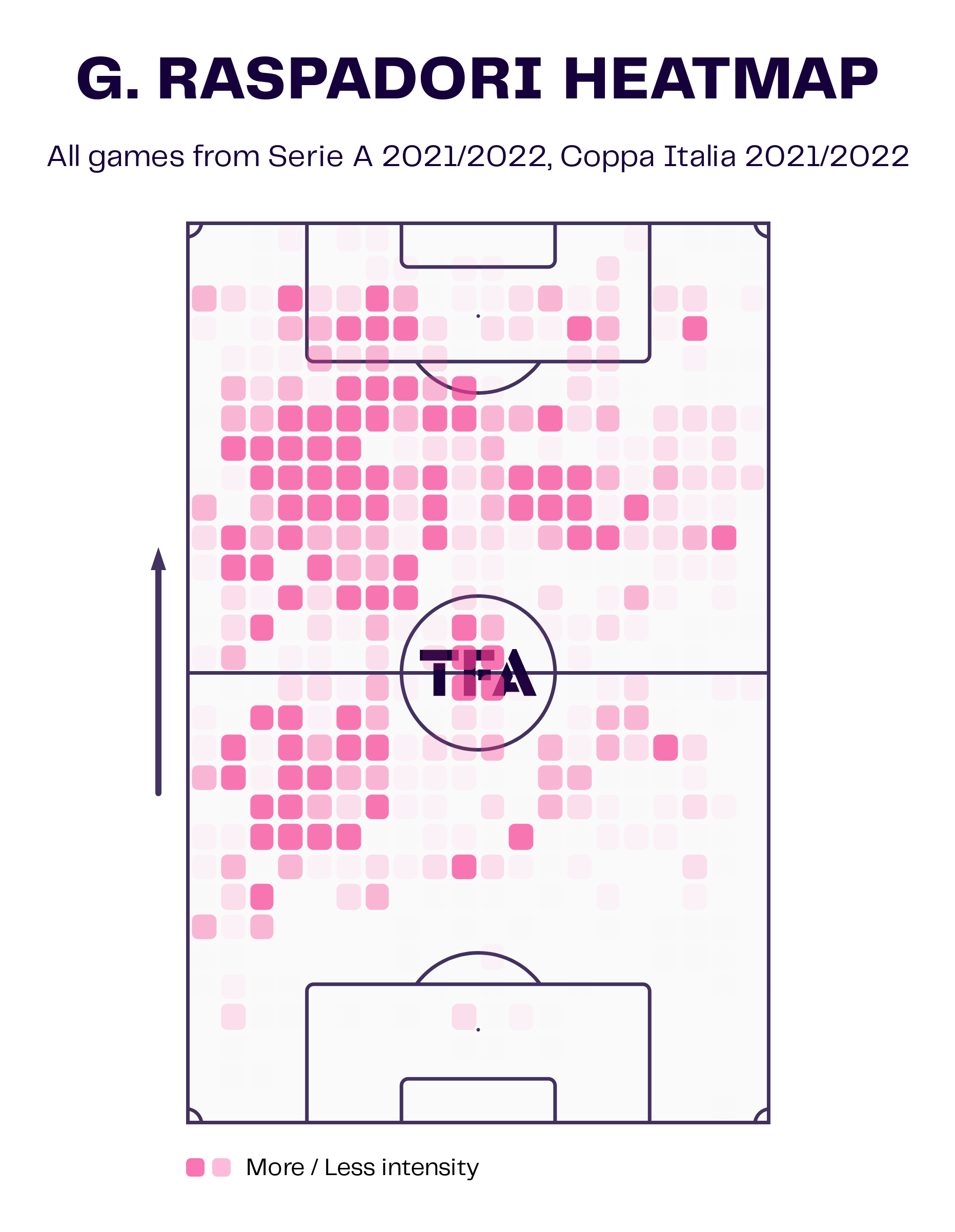
However, this time around, for club and country, Raspadori has been starting as a centre-forward.
Unfortunately, with Napoli, given how influential Victor Osimhen has been once again this season, Raspadori has been forced to wait patiently for his turn up front.
Regardless, the player’s heatmap has been much more centralised in the current campaign.
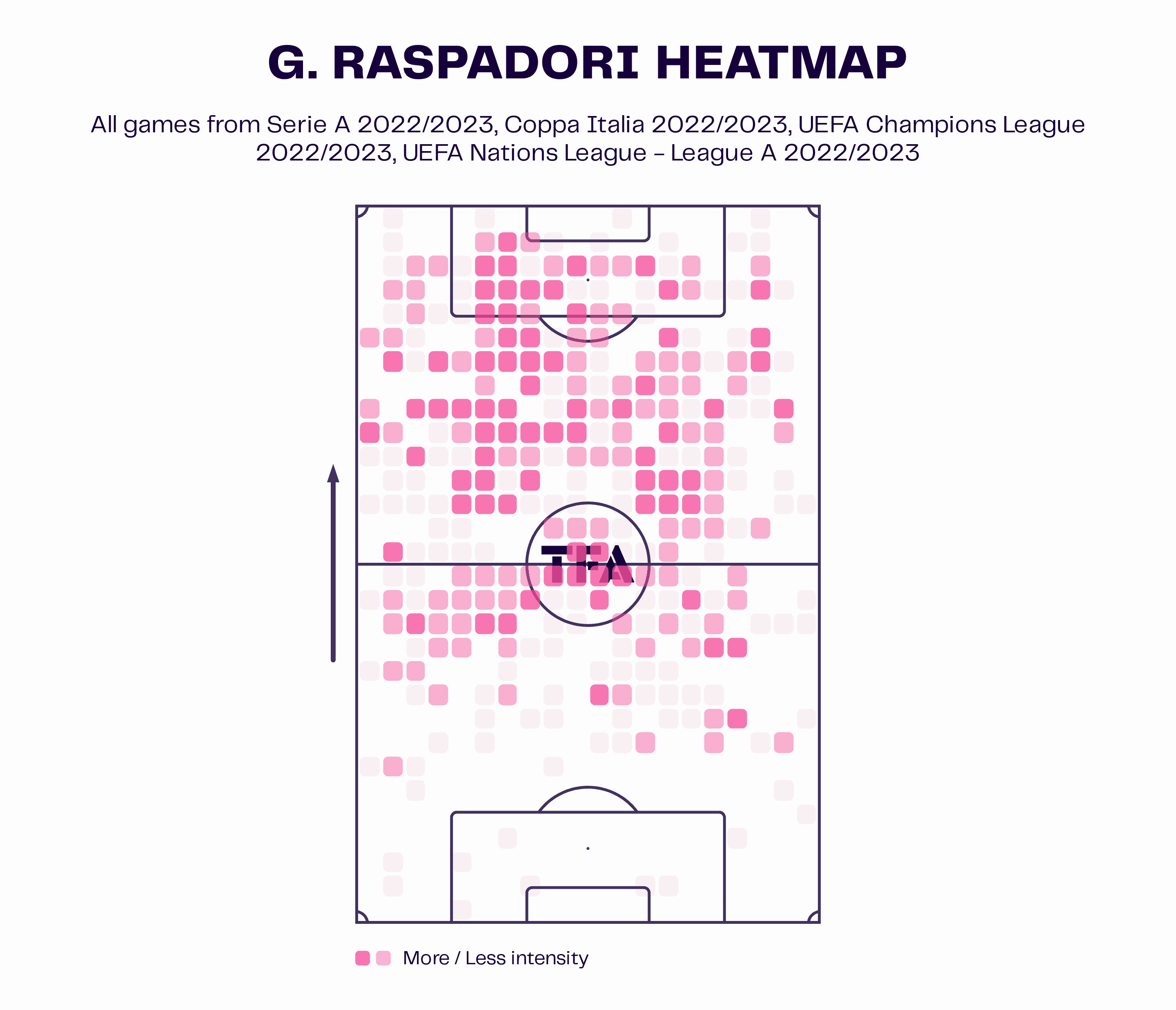
There is quite a lot of movement in the deeper areas of the pitch too. This shows that Raspadori loves to drop deep and link up play with teammates around the ball, acting as a progressive passing option between the lines, which will be analysed in further detail later in this scout report.
Now that we have taken a quick look at Raspadori’s physical and playing profile, let’s dive into what makes the Italian so special as well as what areas can be improved on in his overall game.
Link-up play and runs in behind
It has become almost a cliché in football to say that a centre-forward is great at ‘dropping deep and linking up the play’. If you’ve heard these words, you’ve more than likely been to a pub at 3pm on a Saturday. So, at risk of sounding four pints of Guinness deep, Raspadori is great at dropping deep and linking up the play.
But what exactly does this entail? It does not actually mean that the Italian is great at creating opportunities for others in and around the box. In fact, this is one of the weakest areas of his game.
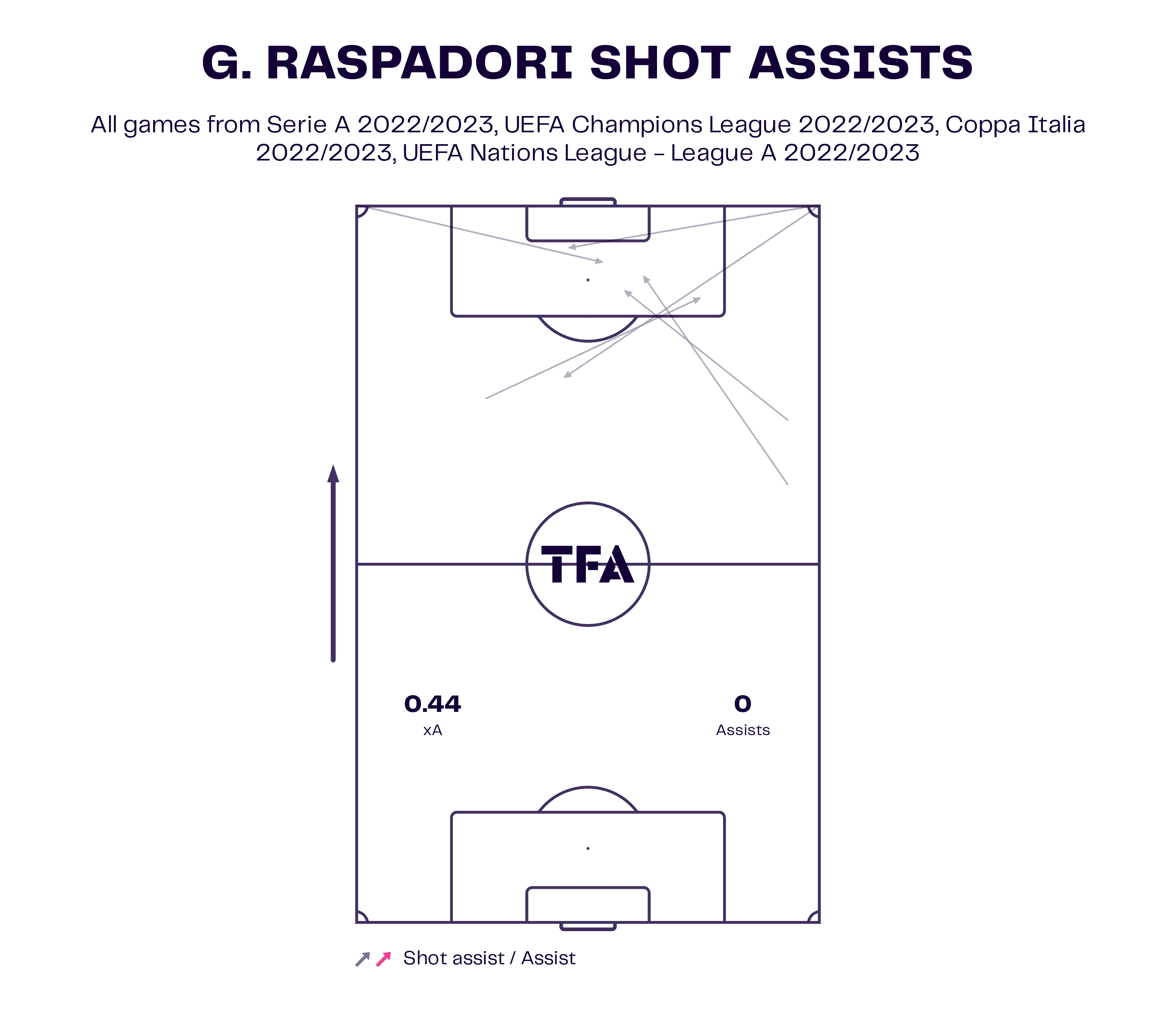
In all competitions for club and country, Raspadori has registered an expected assists (xA) tally of 0.44 and has not managed to make one real assist.
However, linking the play means that Raspadori always drops deep to show for the ball to try and play teammates in behind. At Napoli, the striker has found a nice partnership despite his limited game-time with Khvicha Kvaratskhelia. The duo have a wonderful understanding of when Raspadori drops, Kvaratskhelia runs in behind waiting for the first-time ball.
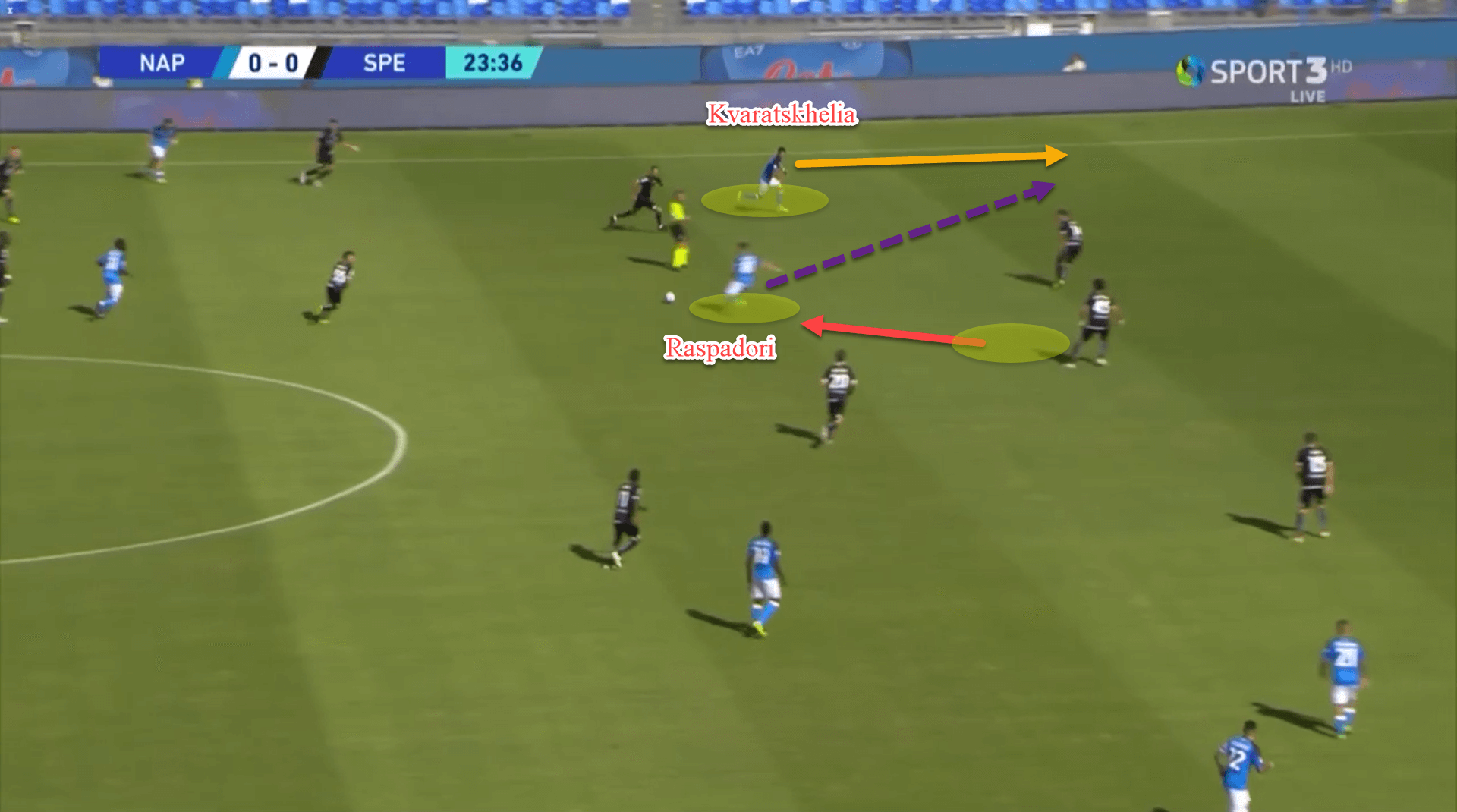
Raspadori is a great progressive passing option for any side he features in. Naturally, the striker comes short to receive the ball between the lines which is a superb asset for any team when trying to break down an opponent’s defensive block.
Nevertheless, it would be useless if the youngster was poor with the ball at his feet as his teammates would not be comfortable playing into him since there would be a large chance that the centre-forward would be dispossessed.
Thankfully, for Napoli and Italy, Raspadori has wonderful ball control and uses his smaller frame incredibly well to hold off even the strongest of opponents. While being merely 5’8”, the number ‘9’ has very powerful hips and his hold-up play is one of the best in Serie A.
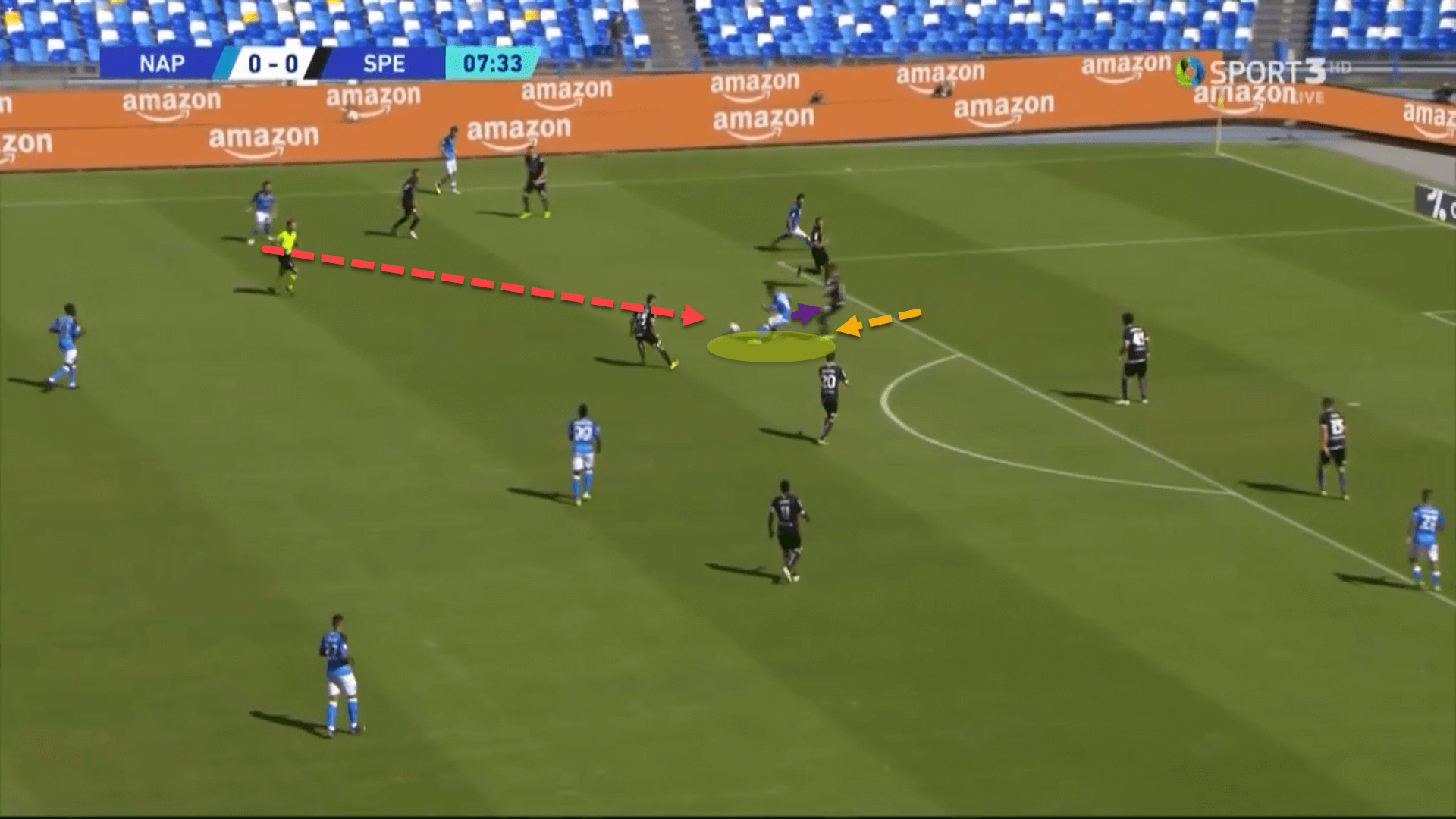
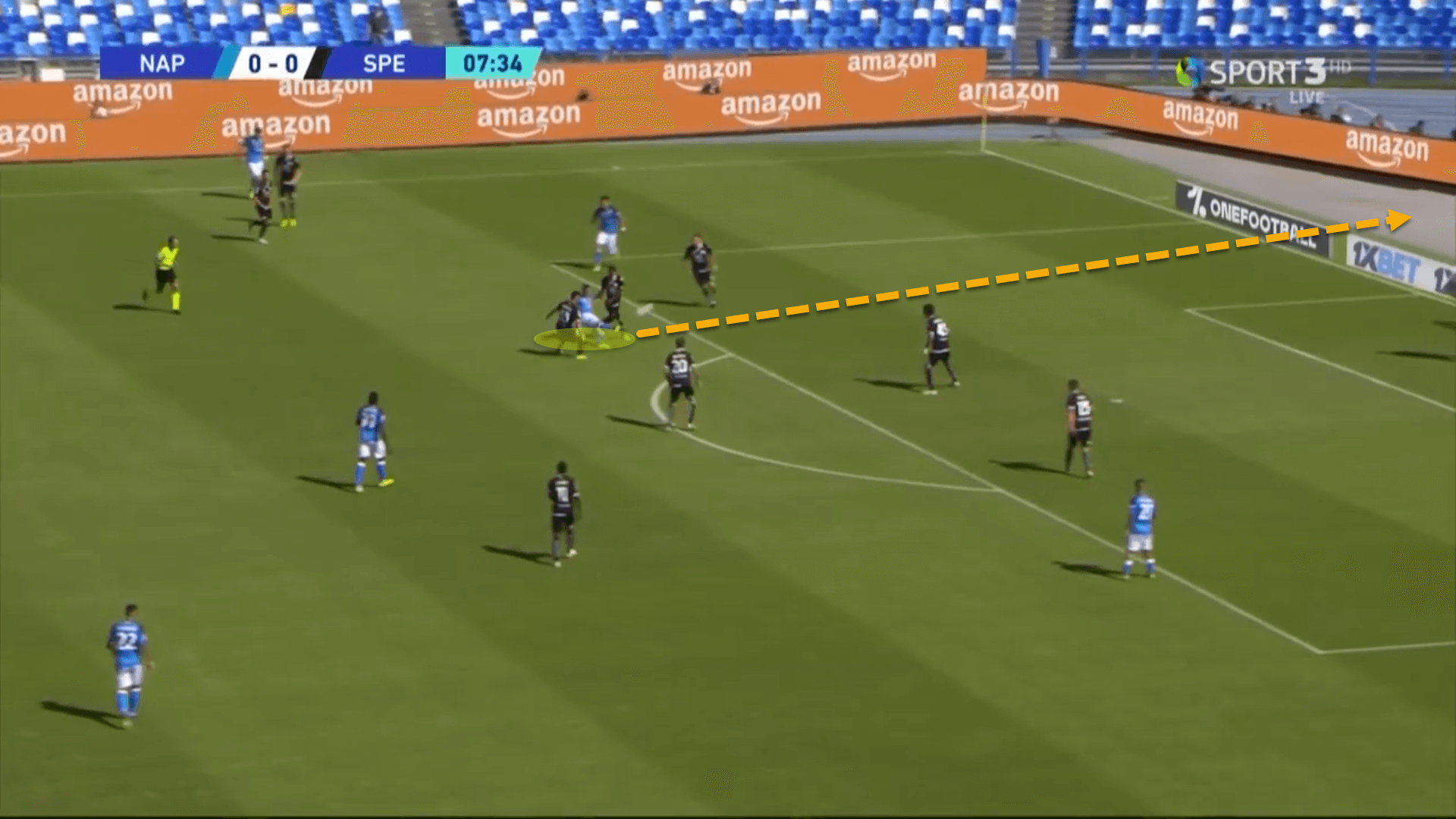
This is an excellent example of how Raspadori used his greatest assets to get a shot away. Having dropped short, the Italian received the ball between the lines but was instantly jumped by a defending Spezia player.
Instead of shying away from the pressure, Raspadori backed into the marker, using his hips to prevent him from being able to hook his leg around and nip the ball. Then, the 22-year-old spun on the ball and fire a half-volley which went wayward over the bar but could have ended in a goal.
Raspadori also uses his hold-up play, ball control and ability to rapidly turn on the ball to progress play for Napoli and Italy. As can be seen from the data viz below, these primarily occur in the final third and around the penalty area.
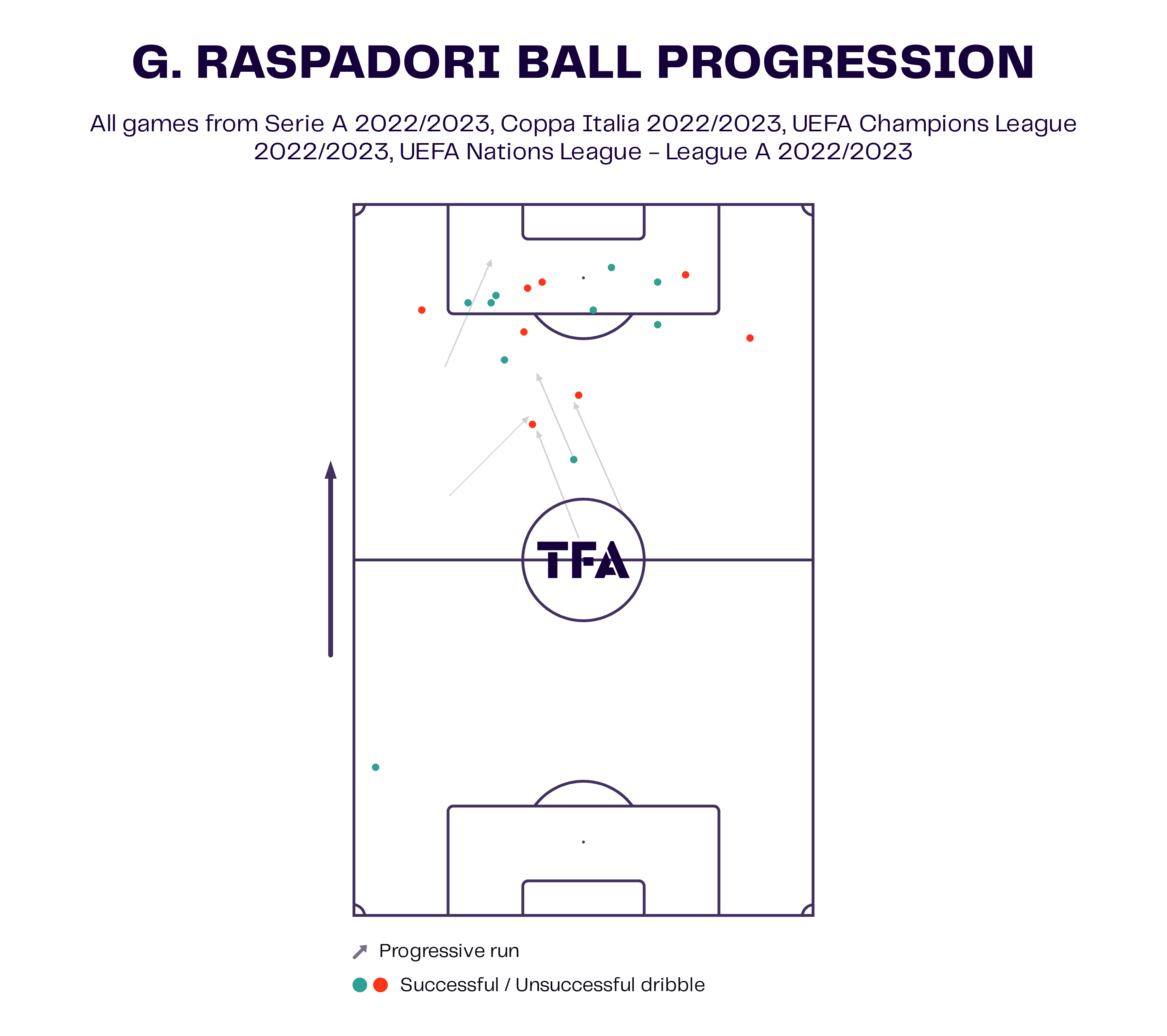
Again, using his body well, Raspadori likes to scan over his shoulder and wait for the opponent to get tight to him. From there, he is able to work his magic and turn either way due to his ability to control the ball well even with his weaker foot.
As the defensive player is tighter to him, Raspadori can flick the ball left or right and dribble past them to advance further through dribbling.
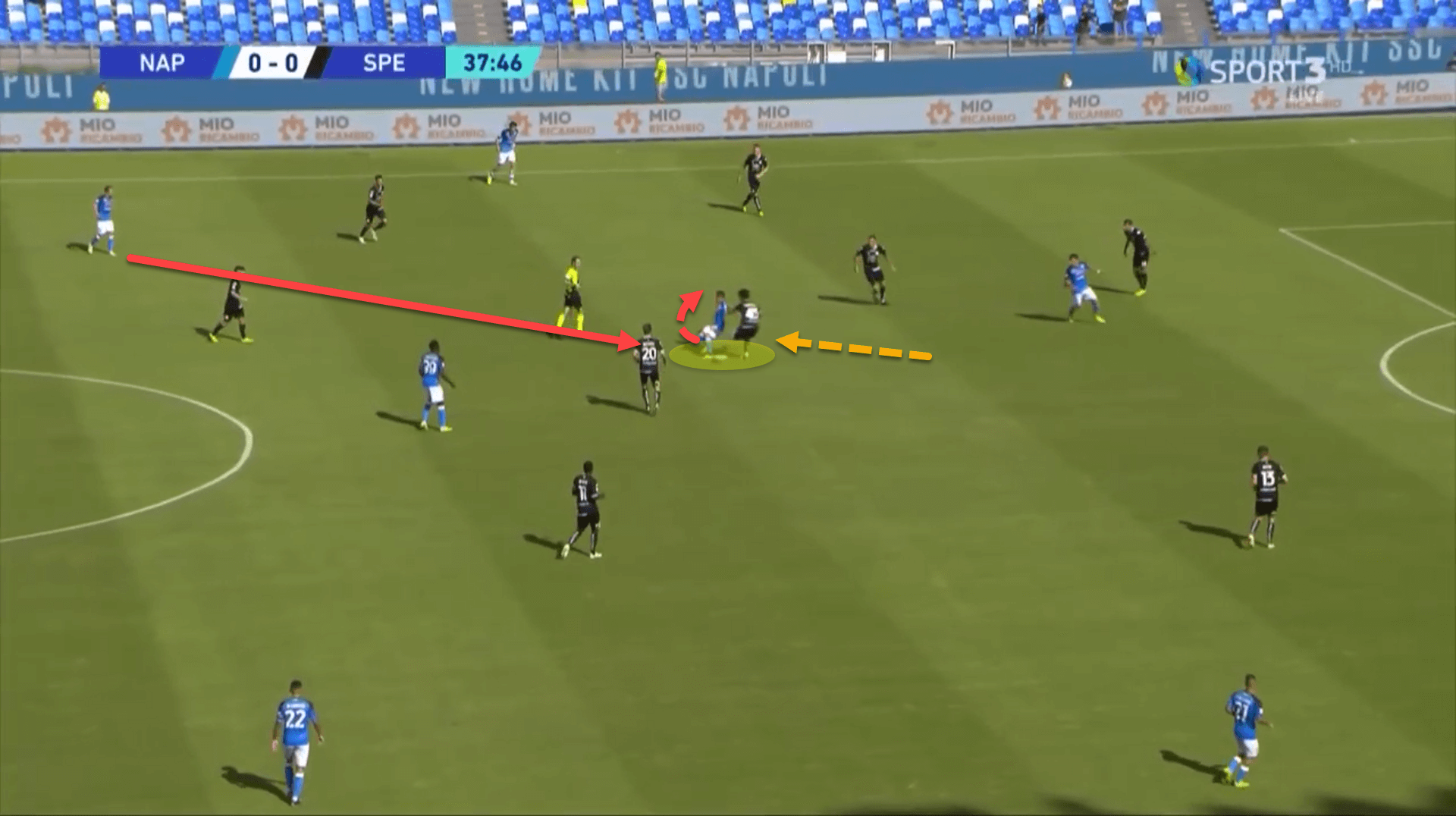
Here, the Spezia defender darted out to close Raspadori down who had dropped deep to receive. Having seen the defender coming, Raspadori waited and waited before pushing the ball to the right and beating him on the dribble.
The striker has attempted 2.47 dribbles per game in all competitions this season and boasts a success rate of 58.3 percent.
Runs in behind
While being incredibly useful at coming short to advance play for his teams, Raspadori is equally as astute at attacking the depth in order to stretch the opposition vertically with his runs in behind.
The forward is excellent at spotting space in the opponent’s defensive line which allows his teammates to play balls into the channels between the fullbacks and central defenders, or ‘around the corner’ for those from a more old-school Sunday league background.
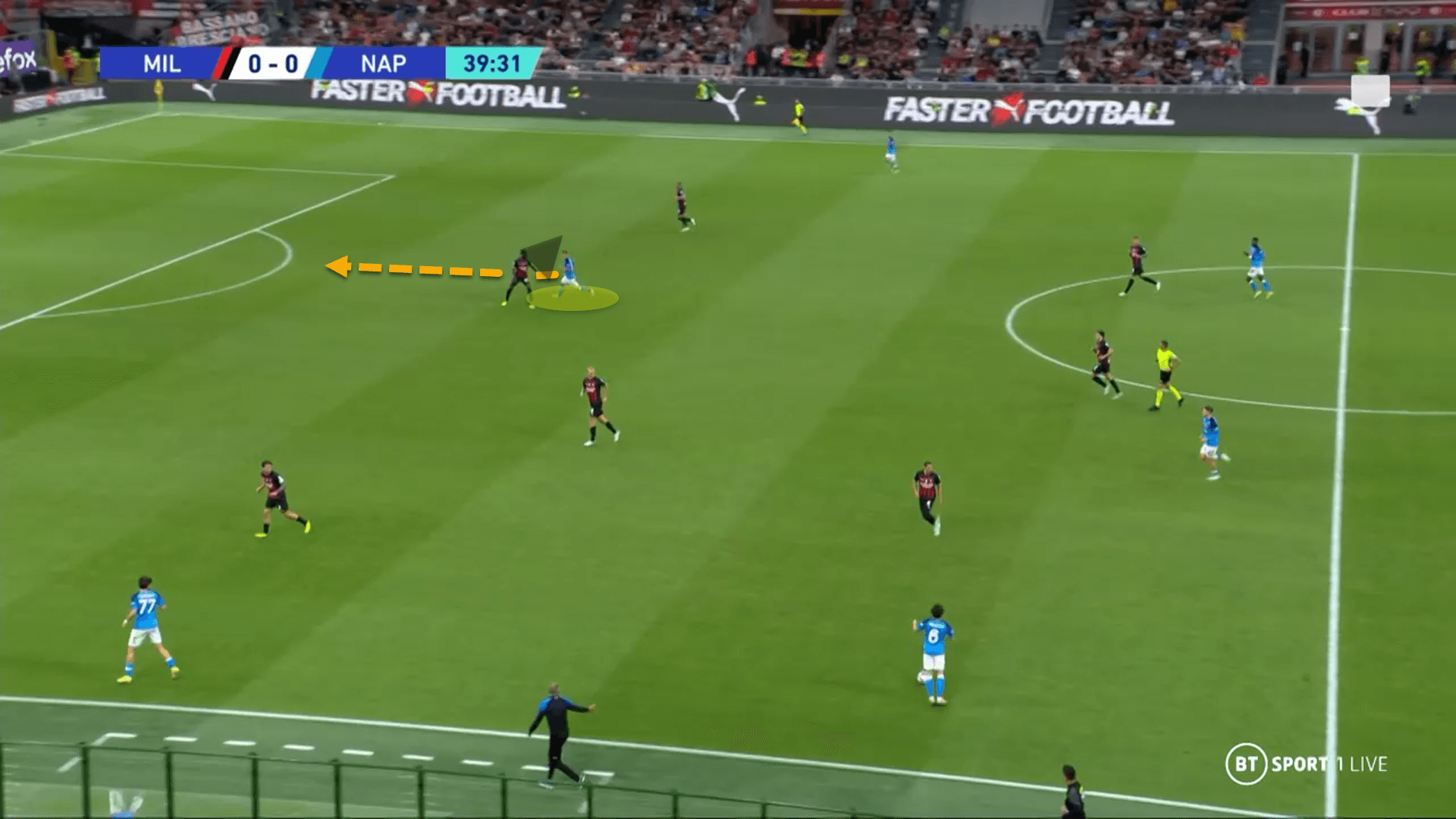
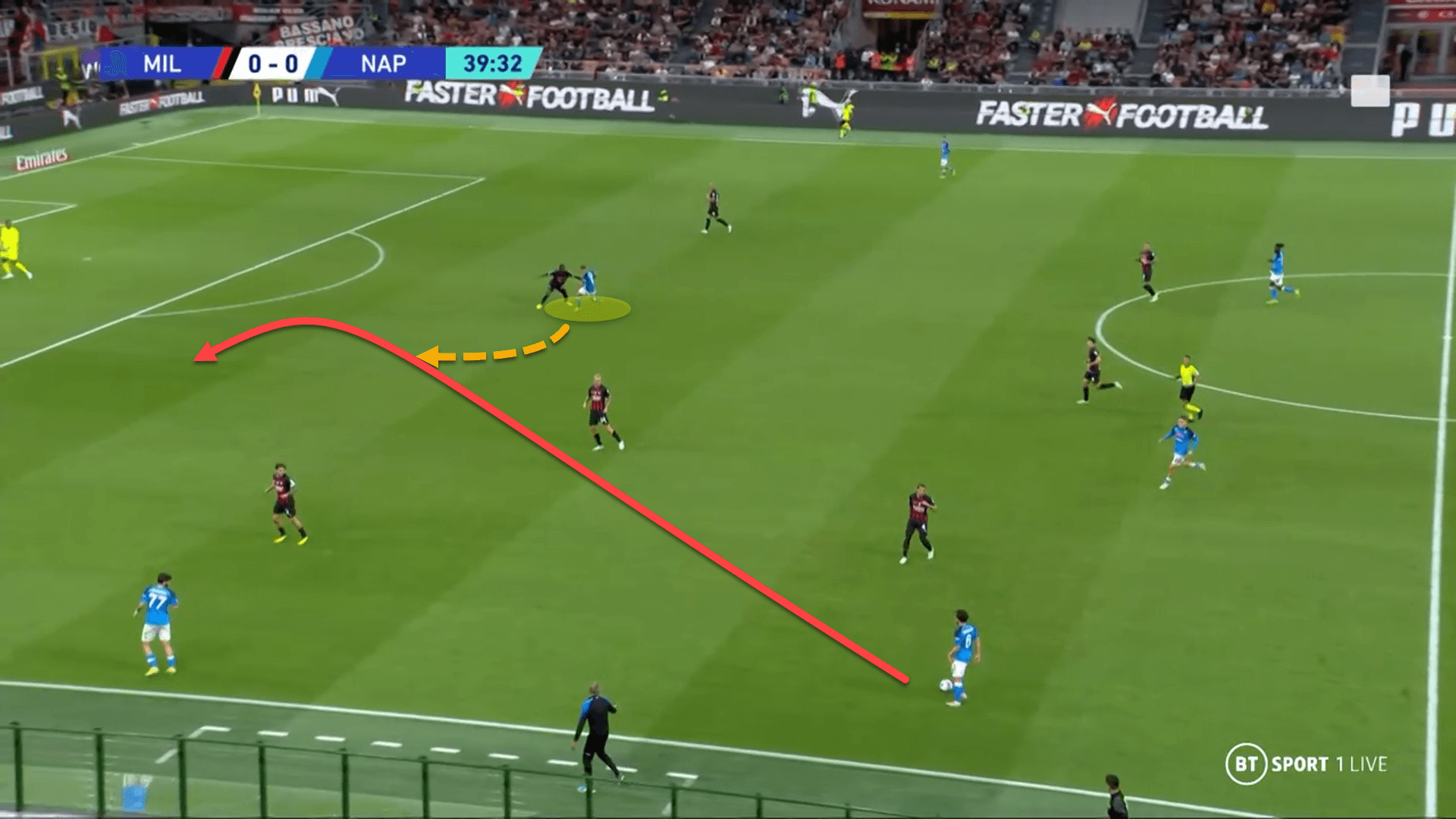
The most fascinating aspect of Raspadori’s ability to run into the channels is how he is able to flat foot marking defenders in a way that is very reminiscent of Barcelona and Liverpool great Luis Suárez.
For instance, the two examples above highlight this perfectly. AC Milan’s centre-back Simon Kjær is out of position in the Rossoneri’s 4-2-3-1. Spotting this, Raspadori sits on the blindside of Kjær’s partner and England international Fikayo Tomori, giving the centre-back a false sense of security that he poses little threat.
Raspadori starts his run, moving directly towards the goal before quickly dipping inside and into the space vacated by Kjær. The Italy international doesn’t receive the ball, unfortunately, but it was still an excellent opportunity for Napoli to advance into the final third, created by Raspadori’s intelligent off-the-ball movement to flat foot Tomori and gain an advantage on the speedy defender in a race.
However, Raspadori’s threat from runs in behind were most evident in Italy’s recent win against England in the UEFA Nations League. Not only did Raspadori score a wonderful goal from such a situation, but Southgate’s side were warned just seven minutes prior in an almost identical scenario.
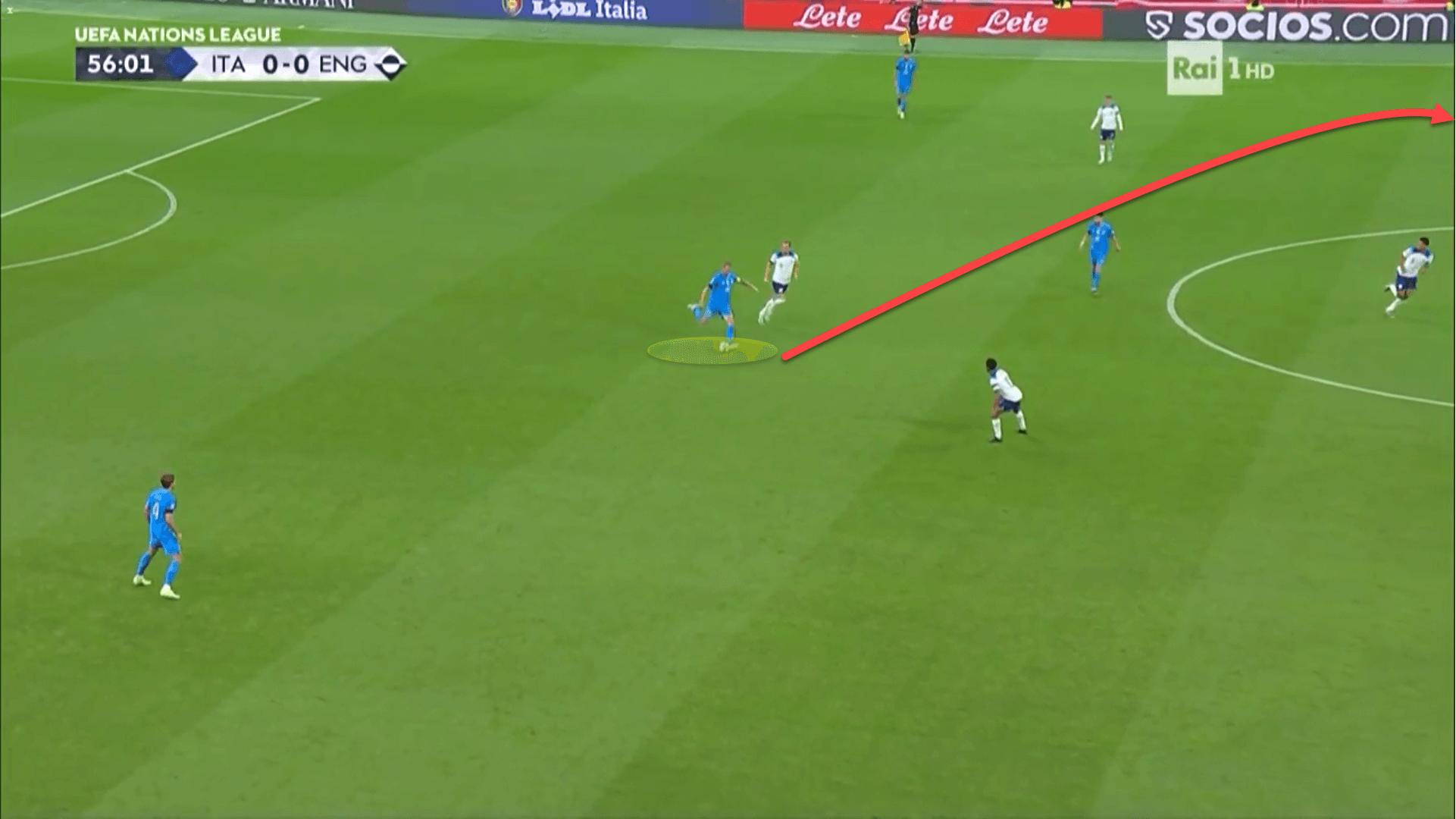
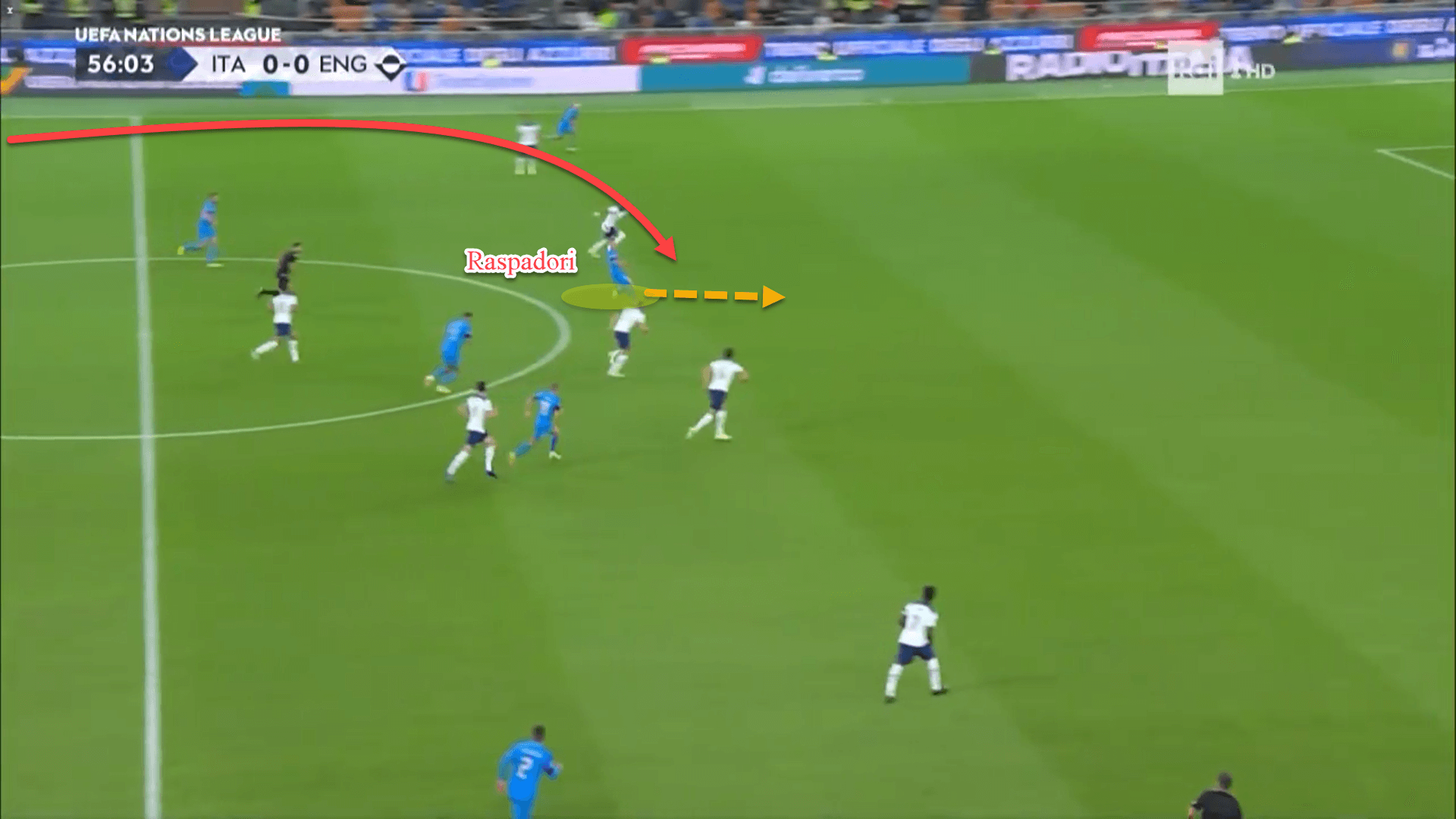
Bonucci sprayed the ball over the top towards Raspadori who trapped the ball with ease. This time, his touch strayed backwards but the forward still held it close to his body.
Using the run of Federico Dimarco in behind, Raspadori played in his wingback who eventually fired the ball across to Nicolo Barella but the Internazionale mezzalla could steer it goalward from the six-yard box.
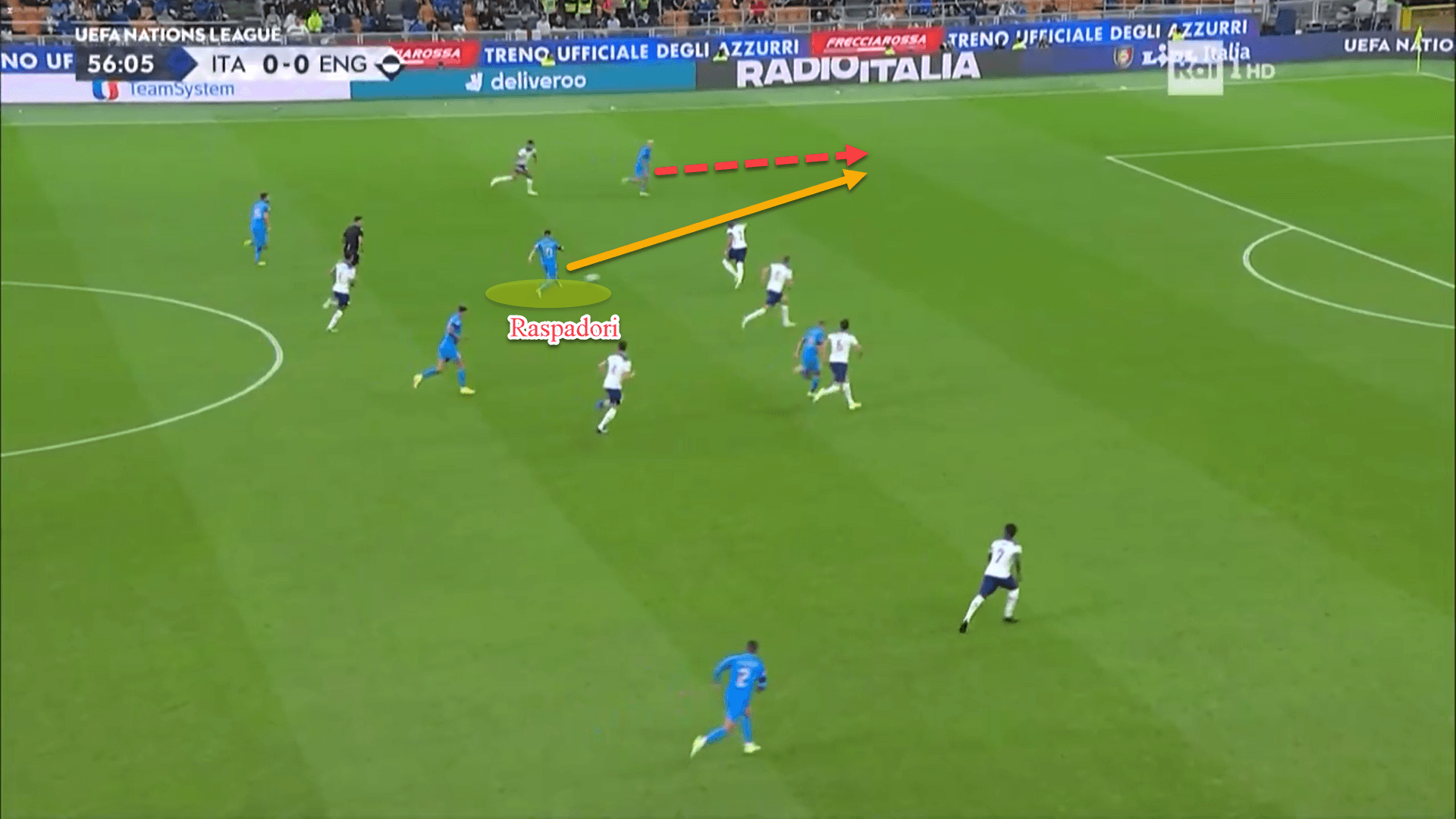
Then came the goal. Having failed to deal with Raspadori’s movement just a few minutes prior, Bonucci was allowed to play the exact same ball over the top towards the centre-forward.
Unfortunately for England, Raspadori’s touch moved the ball forward this time around. After Walker squared him up, the 22-year-old dropped his shoulder and bagged the winner for Roberto Mancini’s European Championships.
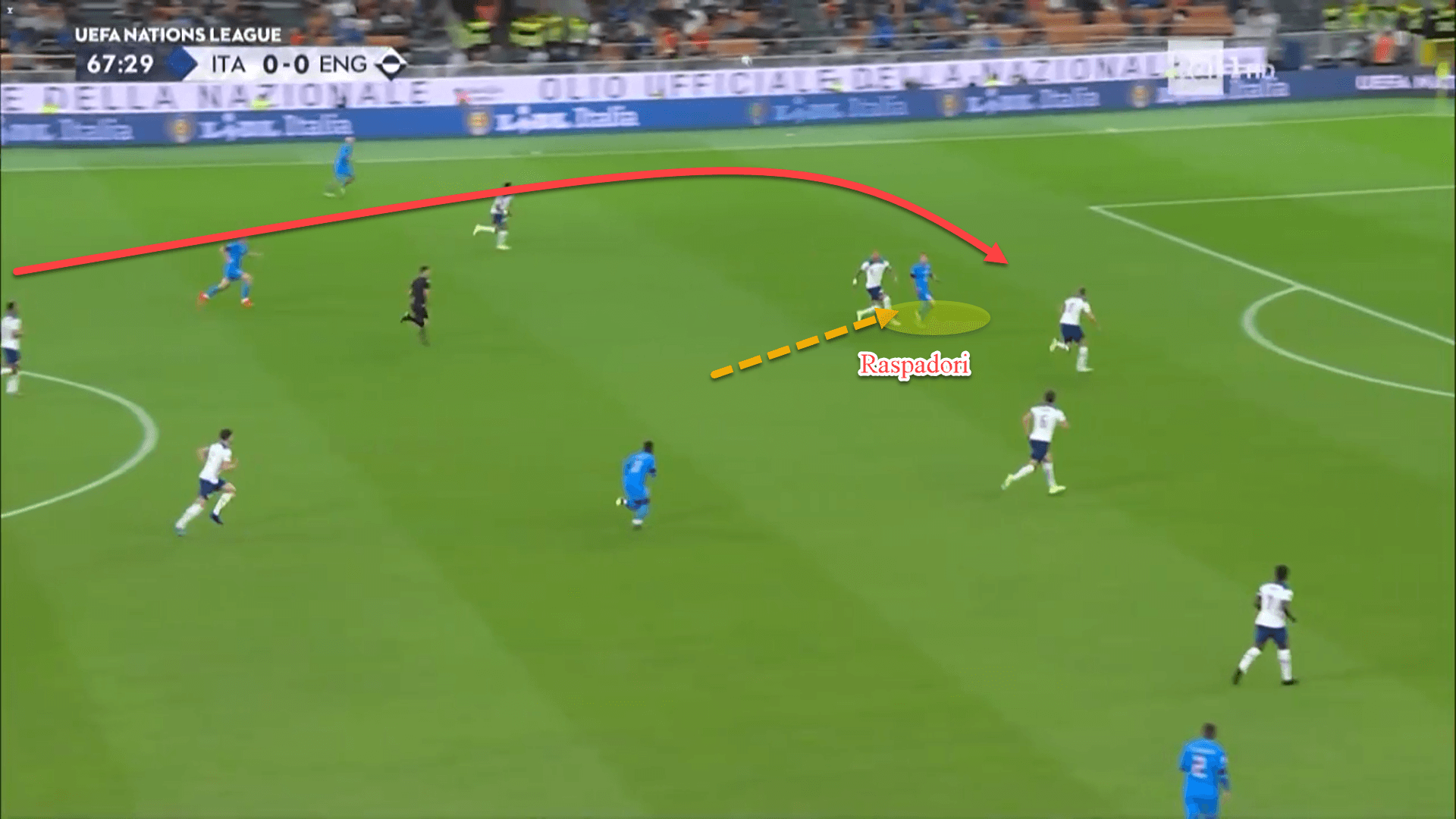
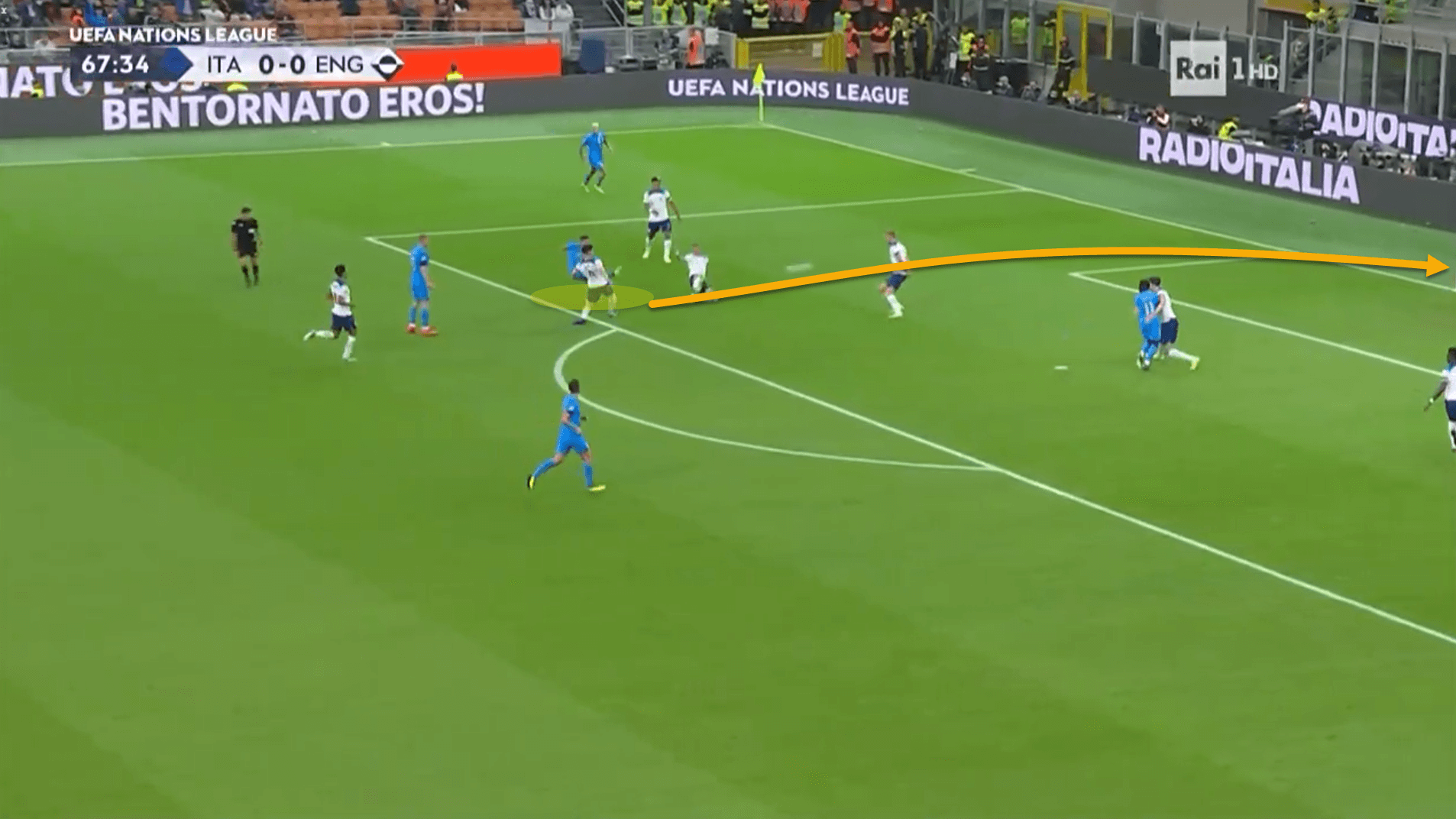
England simply couldn’t cope with Raspadori’s movement in behind and his close control which ultimately cost the Three Lions at the San Siro.
Threat in the box
Inside the penalty area is where Raspadori does his best work. A fox in the box would be an incorrect phrase to describe his ability in front of goal but the forward is still a menace in and around the penalty area.
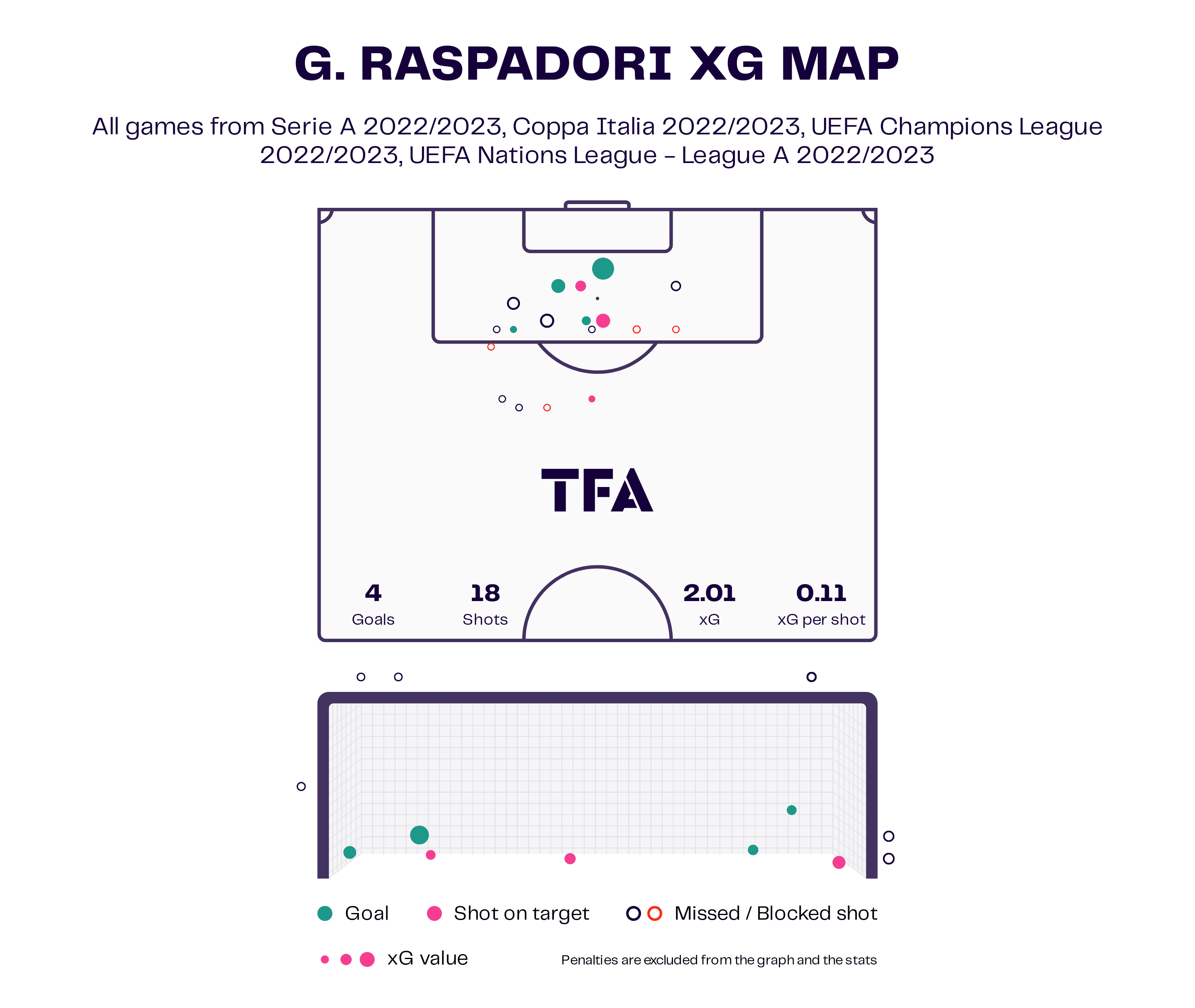
From 18 shots in total this season for club and country in all competitions, Raspadori has scored 4 goals and is currently outperforming his xG of 2.01 by almost double.
What’s more impressive is that Raspadori has scored these four goals with an xG per shot rate of 0.11 which is really low for a centre-forward. Getting himself into better goalscoring positions is definitely something that needs to be improved upon by the Italy international.
But why are the quality of chances that Raspadori takes so low? The reason is that the youngster likes to create goalscoring opportunities himself rather than forming chances through movement.
Essentially, what this means is that Raspadori has a tendency to want to receive the ball to feet before taking on opposition defenders, beating them through dribbling before popping one off at goal.
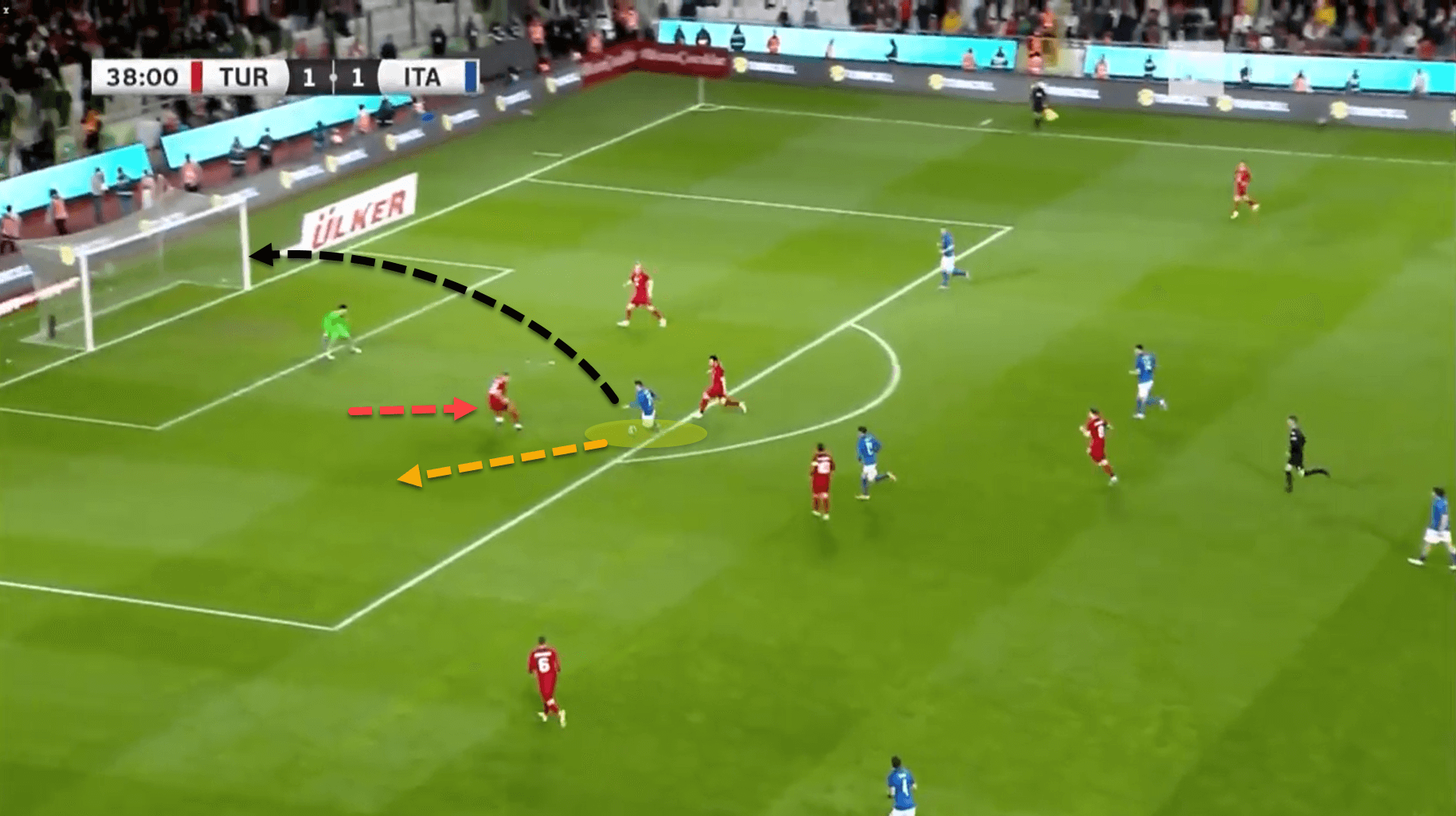
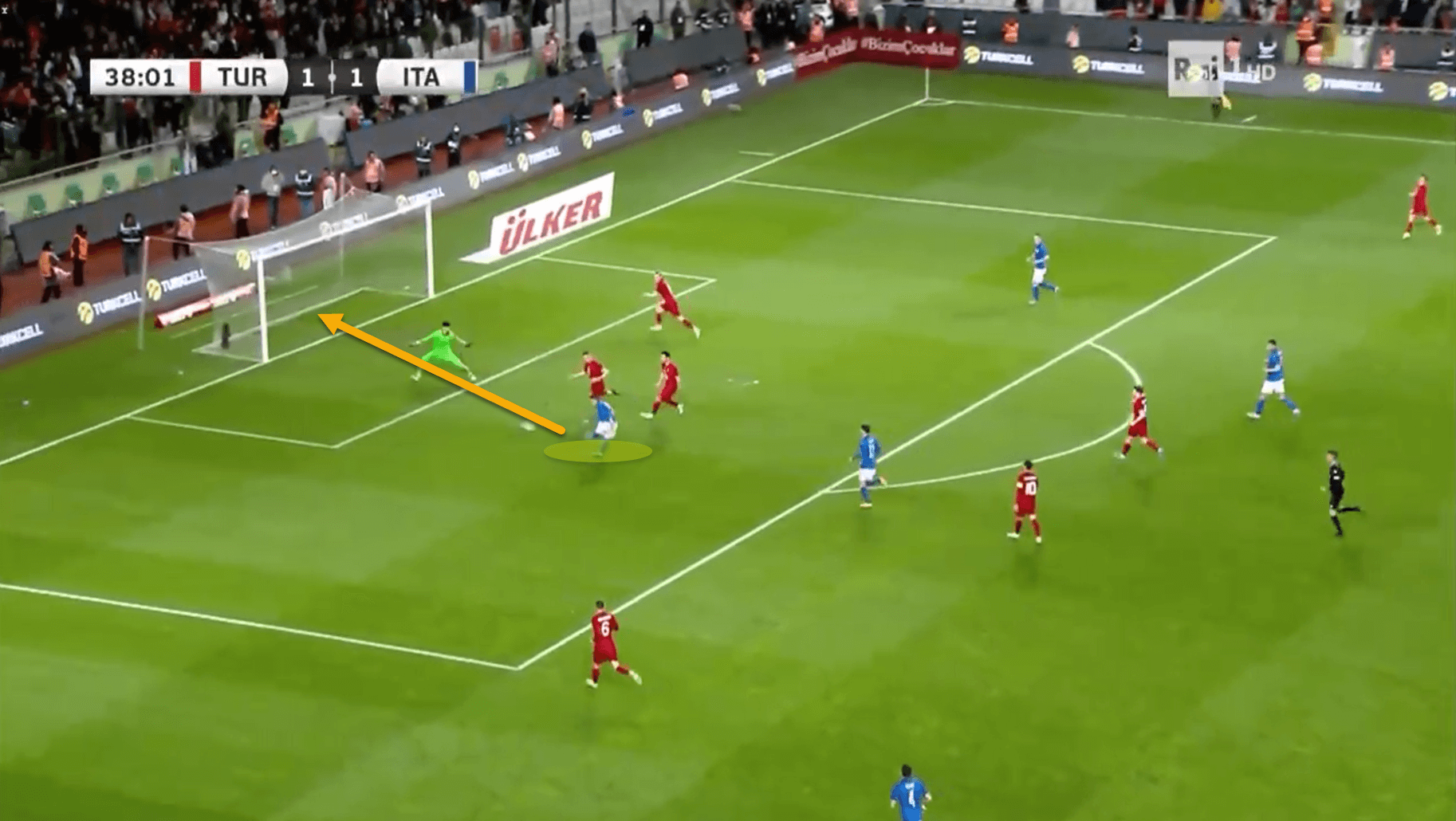
For instance, here, Italy win the ball through high pressing. It eventually falls to Raspadori who has the perfect opportunity to bend one around the goalkeeper at the far post, albeit with a defender onrushing to close down the ball.
Instead, the 22-year-old takes the ball inside, beating the Turkey player with a drop of the shoulder and smashing it past the goalkeeper with his not-so-weak left foot.
Quite a lot of his goals are similar to this strike against Turkey or else are a classic give and go which he also prefers on the odd occasion.
However, for Raspadori to get himself into higher xG positions, the Italian needs to improve his movement when his team are in wide areas.
Very often, Napoli or Italy get into the wide spaces and look to cross into the box. But with Raspadori leading the line, these crossing opportunities tend to be wasted because the forward almost always comes out to the edge of the area to receive to feet.
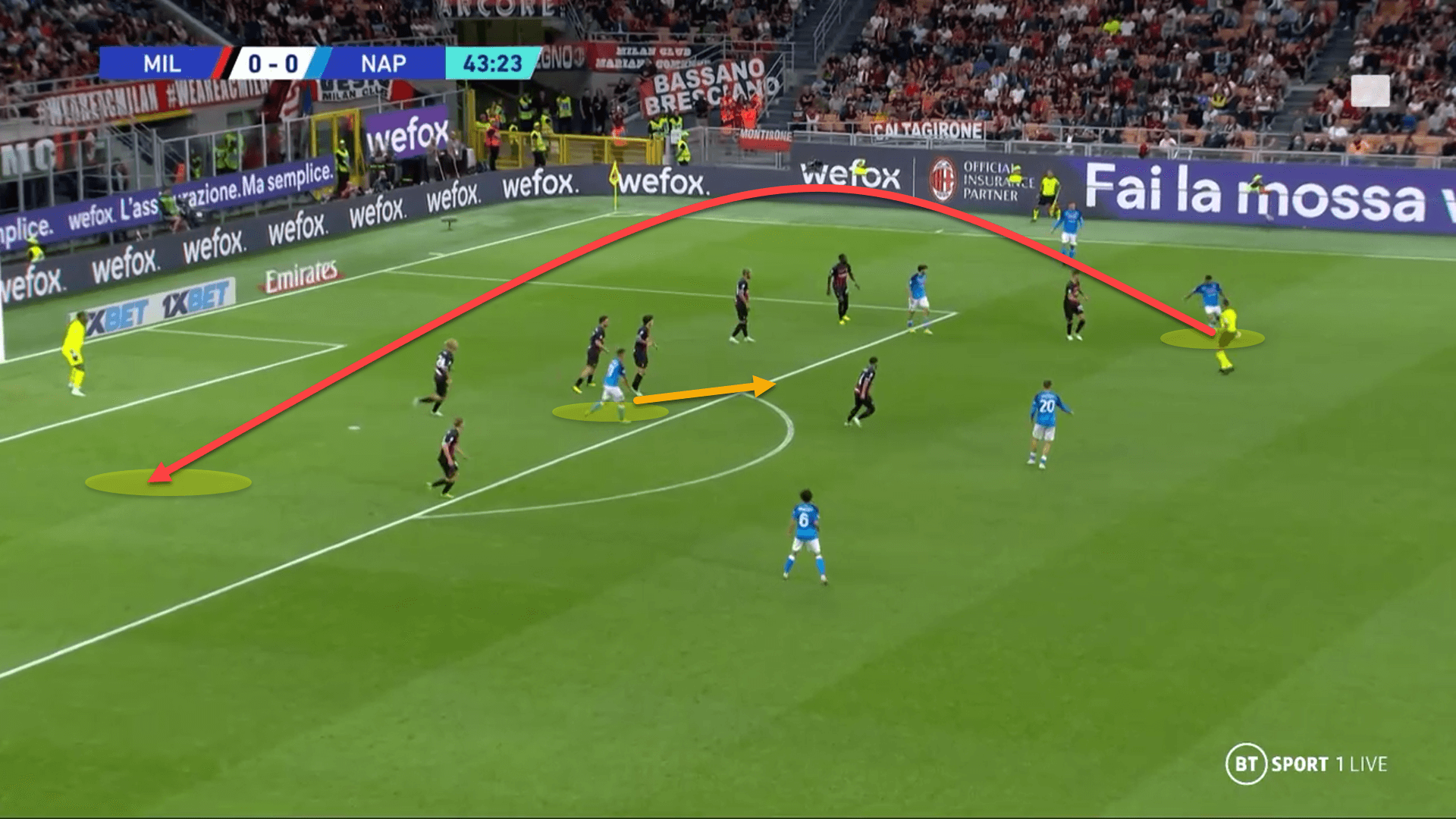
In this example, the Napoli player is looking to whip the ball to the back-post where Raspadori should be. Instead, he has dropped deep outside the area and is calling for the ball to feet.
Of course, Raspadori will not be dominant in the air given his smaller frame compared to the average centre-back, but as Agüero proved in the most physical league in the world with the plethora of headed goals he scored over the years, good movement always trumps height.
Raspadori’s off-the-ball movement is already excellent, as shown by his intelligent runs in behind but the loanee needs to add this to his arsenal in the penalty box so he can get better chances which will potentially lead to a higher goal tally.
Conclusion
Raspadori has all the correct tools to be a world-class centre-forward in the future and is already becoming a mainstay for the Azzurri.
Watching him play is very reminiscent of a hybrid of Agüero and Suárez and it’s clear to see that the number ‘9’ has the potential to be one of the most menacing in Italian football over the next decade.
However, Raspadori needs to start being more reliant on others and less reliant on himself to score goals in order to become a top, top striker in the coming years. His development will be fascinating to watch over the next few seasons.






Comments